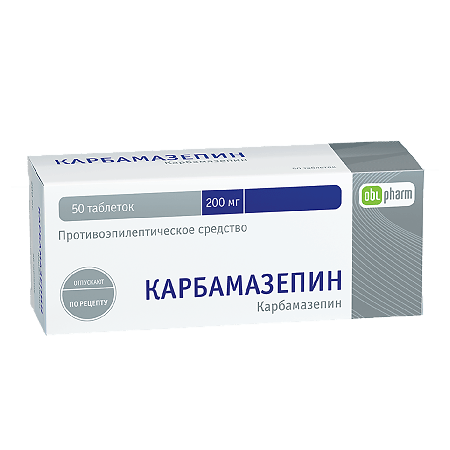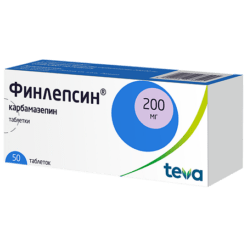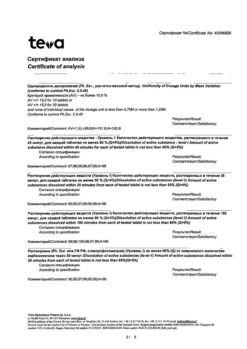No products in the cart.
Carbamazepine, tablets 200 mg 50 pcs
€1.00
Out of stock
(E-mail when Stock is available)
Description
The antiepileptic agent (dibenzazepine derivative) which also has normotensive, antimanic, antidiuretic (in patients with non-sugar diabetes) and analgesic (in patients with neuralgia) effects.
The mechanism of action is associated with blockade of potential-dependent Na+-channels, which leads to stabilization of the neuronal membrane, inhibition of the occurrence of serial discharges of neurons and reduction of synaptic conduction of impulses. Prevents the reformation of Na+-dependent action potentials in depolarized neurons. Reduces the release of the excitatory neurotransmitter amino acid glutamate, increases the reduced seizure threshold and thus reduces the risk of an epileptic seizure. Increases conductance for K+, modulates potential-dependent Ca2+ channels, which may also determine the anticonvulsant effect of the drug. Corrects epileptic personality changes and, eventually, increases patients’ communicability and contributes to their social rehabilitation. It can be prescribed as the main therapeutic drug and in combination with other anticonvulsants. It is effective in focal (partial) epileptic seizures (simple and complex), accompanied or not accompanied by secondary generalization, in generalized tonic-clonic epileptic seizures, as well as in combinations of these types (usually ineffective in small seizures – petit mal, absences and myoclonic seizures).
In patients with epilepsy (especially in children and adolescents) a positive effect on symptoms of anxiety and depression, as well as reduction of irritability and aggressiveness was noted. The effect on cognitive function and psychomotor performance is dose-dependent and highly variable.
The onset of anticonvulsant effect varies from several hours to several days (sometimes up to 1 month due to autoinduction of metabolism). In essential and secondary trigeminal neuralgia it prevents the occurrence of painful attacks in most cases. It is effective for relief of neurogenic pain in spinal tenderness, post-traumatic paresthesias and post-herpetic neuralgia. Relief of pain in trigeminal neuralgia is noted in 8-72 hours. In alcohol withdrawal syndrome it increases the threshold of seizure readiness (which is usually lowered in this condition) and reduces the severity of clinical manifestations of the syndrome (increased excitability, tremor, gait disturbances).
In patients with non-sugar diabetes it leads to rapid compensation of the water balance, reduces diuresis and the feeling of thirst.
The antipsychotic (antimanic) effect develops in 7-10 days, may be due to inhibition of dopamine and noradrenaline metabolism.
Indications
Indications
Epilepsy (excluding absence seizures, myoclonic or flaccid seizures) – partial seizures with complex and simple symptoms, primary and secondary generalized forms of seizures with tonic-clonic seizures, mixed forms of seizures (monotherapy or in combination with other anticonvulsants); idiopathic trigeminal neuralgia, trigeminal neuralgia in multiple sclerosis, idiopathic glossopharyngeal neuralgia, alcohol withdrawal syndrome, treatment of affective disorders, polydipsia and polyuria in diabetes insipidus, pain syndrome in diabetic polyneuropathy.
Prevention of phasic affective disorders (manic-depressive psychosis, schizoaffective disorders, etc.).
Pharmacological effect
Pharmacological effect
An antiepileptic drug (dibenzazepine derivative), which also has a normothimic, antimanic, antidiuretic (in patients with diabetes insipidus) and analgesic (in patients with neuralgia) effect.
The mechanism of action is associated with the blockade of voltage-gated Na+ channels, which leads to stabilization of the neuronal membrane, inhibition of the occurrence of serial neuronal discharges and a decrease in synaptic conduction of impulses. Prevents the repeated formation of Na+-dependent action potentials in depolarized neurons. Reduces the release of the excitatory neurotransmitter amino acid glutamate, increases the reduced seizure threshold, etc. reduces the risk of developing an epileptic attack. Increases conductivity for K+, modulates voltage-gated Ca2+ channels, which can also determine the anticonvulsant effect of the drug. Corrects epileptic personality changes and, ultimately, increases the sociability of patients and promotes their social rehabilitation. It can be prescribed as the main therapeutic drug and in combination with other anticonvulsants. Effective for focal (partial) epileptic seizures (simple and complex), accompanied or not accompanied by secondary generalization, for generalized tonic-clonic epileptic seizures, as well as a combination of these types (usually ineffective for small seizures – petit mal, absence seizures and myoclonic seizures).
In patients with epilepsy (especially children and adolescents), a positive effect on symptoms of anxiety and depression, as well as a decrease in irritability and aggressiveness, was noted. The effect on cognitive function and psychomotor performance is dose dependent and highly variable.
The onset of the anticonvulsant effect varies from several hours to several days (sometimes up to 1 month due to autoinduction of metabolism). In case of essential and secondary neuralgia of the trigeminal nerve, in most cases it prevents the occurrence of painful attacks. Effective for relieving neurogenic pain from tabes spinal cord, post-traumatic paresthesia and postherpetic neuralgia. Relief of pain in trigeminal neuralgia is observed after 8-72 hours. In alcohol withdrawal syndrome, it increases the threshold of convulsive readiness (which is usually reduced in this condition) and reduces the severity of the clinical manifestations of the syndrome (increased excitability, tremor, gait disturbances).
In patients with diabetes insipidus, it leads to rapid compensation of water balance, reduces diuresis and the feeling of thirst.
The antipsychotic (antimanic) effect develops after 7-10 days and may be due to inhibition of the metabolism of dopamine and norepinephrine.
Special instructions
Special instructions
Before starting treatment, it is necessary to conduct a general blood test (including platelet and reticulocyte counts), a general urinalysis, and determine the level of iron, concentrations of electrolytes and urea in the blood serum. Subsequently, these indicators should be monitored weekly during the first month of treatment and then monthly. When prescribed to patients with increased intraocular pressure, periodic monitoring is necessary. Non-progressive asymptomatic leukopenia does not require discontinuation, however, treatment should be discontinued if progressive leukopenia or leukopenia accompanied by clinical symptoms of an infectious disease occurs.
Information about the possible effect of a medicinal product for medical use on the ability to drive vehicles and machinery. During the treatment period, care must be taken when driving vehicles and engaging in other potentially hazardous activities that require increased concentration and speed of psychomotor reactions.
Active ingredient
Active ingredient
Carbamazepine
Composition
Composition
One tablet contains:
Active substance – carbamazepine 200 mg;
Excipients: colloidal silicon dioxide (Aerosil) 960 mcg, potato starch 96.64 mg, povidone K30 14.4 mg, polysorbate 80 1.6 mg, talc 3.2 mg, magnesium stearate 3.2 mg.
Contraindications
Contraindications
Hypersensitivity to carbamazepine and chemically similar drugs (tricyclic antidepressants) or to any other component of the drug, acute intermittent porphyria (including history), simultaneous use of monoamine oxidase inhibitors (hereinafter referred to as MAO inhibitors) and within 2 weeks after their discontinuation, disorders of bone marrow hematopoiesis, atrioventricular block, pregnancy and period lactation.
With caution. Dilution hyponatremia, old age, alcohol intake, suppression of bone marrow hematopoiesis due to medications (history); prostatic hyperplasia, increased intraocular pressure, severe heart failure, liver failure, chronic renal failure.
Side Effects
Side Effects
From the central nervous system: dizziness, ataxia, drowsiness, general weakness, headache, accommodation paresis, tremor, tics, nystagmus, orofacial dyskinesia, oculomotor disorders, dysarthria, choreoathetoid disorders, peripheral neuritis, paresthesia, muscle weakness and paresis.
From the mental sphere: hallucinations, depression, loss of appetite, anxiety, aggressive behavior, agitation, disorientation, activation of psychosis. Allergic reactions: urticaria, exfoliative dermatitis, erythroderma, lupus-like syndrome, Stevens-Johnson syndrome, toxic epidermal necrolysis, photosensitivity, erythema multiforme and erythema nodosum. Multiorgan delayed-type hypersensitivity reactions with fever, skin rash, vasculitis, lymphadenopathy, lymphoma-like features, arthralgias, leukopenia, eosinophilia, hepatosplenomegaly and altered liver function tests (these manifestations occur in various combinations) are possible. Other organs may also be involved (eg, lungs, kidneys, pancreas, myocardium, colon). Very rarely – aseptic meningitis with myoclonus, anaphylactic reaction, angioedema, pulmonary hypersensitivity reactions characterized by fever, shortness of breath, pneumonitis or pneumonia.
From the hematopoietic organs: leukopenia, thrombocytopenia, eosinophilia, leukocytosis, lymphadenopathy; agranulocytosis, aplastic anemia, true erythrocyte aplasia, megaloblastic anemia, acute intermittent porphyria, reticulocytosis, hemolytic anemia.
From the digestive system (hereinafter referred to as the gastrointestinal tract): nausea, vomiting, dry mouth, diarrhea or constipation, abdominal pain, glossitis, stomatitis, pancreatitis.
From the liver: increased activity of gamma-glutamyltransferase (usually has no clinical significance), increased activity of alkaline phosphatase and “liver” transaminases, hepatitis (granulomatous, cholestatic, parenchymal (hepatocellular) or mixed type); liver failure.
From the cardiovascular system (hereinafter referred to as CVS): intracardiac conduction disorders; decrease or increase in blood pressure; bradycardia, arrhythmias, atrioventricular block with fainting, collapse, worsening or development of congestive heart failure, exacerbation of coronary heart disease (including the appearance or increased frequency of angina attacks), thrombophlebitis, thromboembolic syndrome.
From the endocrine system and metabolism: edema, weight gain, hyponatremia, increased prolactin levels (may be accompanied by galactorrhea and gynecomastia); a decrease in the level of L-thyroxine (free T4, T3) and an increase in the level of thyroid-stimulating hormone (TSH) (usually not accompanied by clinical manifestations), disorders of calcium-phosphorus metabolism in bone tissue (decrease in the concentration of Ca2+ and 25-OH-cholecalciferol in the blood plasma); osteomalacia; hypercholesterolemia and hypertriglyceridemia.
From the genitourinary system: interstitial nephritis, renal failure, renal dysfunction (albuminuria, hematuria, oliguria, increased urea/azotemia), frequent urination, urinary retention, sexual dysfunction/impotence.
From the musculoskeletal system: arthralgia, myalgia or convulsions.
From the senses: disturbances of taste, clouding of the lens, conjunctivitis; hyper- or hypoacusia, changes in the perception of pitch.
Other: skin pigmentation disorders, purpura, acne, sweating, alopecia.
Interaction
Interaction
Carbamazepine increases the activity of microsomal liver enzymes and may reduce the effectiveness of drugs metabolized in the liver. Co-administration of carbamazepine with CYP3A4 inhibitors may lead to an increase in its concentration in the blood plasma. Combined use with CYP3A4 inducers can lead to an acceleration of the metabolism of carbamazepine and a decrease in its concentration in the blood plasma; on the contrary, their cancellation can reduce the rate of biotransformation of carbamazepine and lead to an increase in its concentration.
Increase the concentration of carbamazepine in plasma: verapamil, diltiazem, felodipine, dextropropoxyphene, viloxazine, fluoxetine, fluvoxamine, cimetidine, acetazolamide, danazol, desipramine, nicotinamide (in adults, only in high doses); macrolides (erythromycin, josamycin, clarithromycin, troleandomycin); azoles (itraconazole, ketoconazole, fluconazole), terfenadine, loratadine, isoniazid, propoxyphene, grapefruit juice, viral protease inhibitors used in HIV therapy. Felbamate reduces the plasma concentration of carbamazepine and increases the concentration of carbamazepine-10,11-epoxide, and a simultaneous decrease in the serum concentration of felbamate is possible. The concentration of carbamazepine is reduced by phenobarbital, phenytoin, primidone, methsuximide, fensuximide, theophylline, rifampicin, cisplastine, doxirubicin, possibly clonazepam, valpromide, valproic acid, oxcarbazepine and herbal preparations containing St. John’s wort (Hypericum perforatum). There are reports of the possibility of valproic acid and primidone displacing carbamazepine from binding to plasma proteins and increasing the concentration of the pharmacologically active metabolite (carbamazepine-10,11-epoxide). Isotretinoin alters the bioavailability and/or clearance of carbamazepine and carbamazepine-10,11-epoxide (monitoring of carbamazepine plasma concentrations is necessary). Carbamazepine may reduce plasma concentrations (reduce or even completely eliminate the effects) and require dose adjustment of the following drugs: clobazam, clonazepam, ethosuximide, primidone, valproic acid, alprazolam, glucocorticosteroids (prednisolone, dexamethasone), cyclosporine, doxycycline, haloperidol, methadone, oral drugs containing estrogens and/or progesterone (selection of alternative methods of contraception is necessary), theophylline, oral anticoagulants (warfarin, phenprocoumon, dicumarol), lamotrigine, topiramate, tricyclic antidepressants (imipramine, amitriptyline, nortriptyline, clomipramine), clozapine, felbamate, tiagabine, oxcarbazepine, protease inhibitors used in the treatment of HIV infection (indinavir, ritonavir, saquinovir), calcium channel blockers (dihydropyridone group, for example, felodipine), itraconazole, levothyroxine, midazolam, olazapine, praziquantel, risperidone, tramadol, ciprasidone. There are reports that while taking carbamazepine, the level of phenytoin in the blood plasma can either increase or decrease, and the level of mephenytoin can increase (in rare cases). Carbamazepine, when used together with paracetamol, increases the risk of its toxic effect on the liver and reduces therapeutic effectiveness (acceleration of paracetamol metabolism). The simultaneous administration of carbamazepine with phenothiazine, pimozide, thioxane-thenes, molindone, haloperidol, maprotiline, clozapine and tricyclic antidepressants leads to an increased inhibitory effect on the central nervous system and a weakening of the anticonvulsant effect of carbamazepine. Concomitant administration with diuretics (hydrochlorothiazide, furosemide) can lead to hyponatremia, accompanied by clinical manifestations. Reduces the effects of non-depolarizing muscle relaxants (pancuronium). Reduces ethanol tolerance. Accelerates the metabolism of indirect anticoagulants, hormonal contraceptives, folic acid; praziquantel may enhance the elimination of thyroid hormones. Accelerates the metabolism of general anesthesia agents (enflurane, halothane, ftorotan) with an increased risk of hepatoxic effects; enhances the formation of nephrotoxic metabolites of methoxyflurane. Strengthens the hepatotoxic effect of isoniazid.
Overdose
Overdose
Symptoms: respiratory depression, hyperreflexia alternating with hyporeflexia, hypothermia, depression of gastrointestinal motility, increased severity of side effects.
Treatment: there is no specific antidote. Gastric lavage, administration of activated charcoal (late evacuation of gastric contents can lead to delayed absorption for 2-3 days and reappearance of intoxication symptoms), symptomatic therapy. Forced diuresis, hemodialysis and peritoneal dialysis are ineffective (dialysis is indicated for a combination of severe poisoning and renal failure). Children may require exchange transfusions. It is recommended to carry out hemosorption on carbon sorbents.
Recommendations for use
Recommendations for use
Inside, regardless of food intake, along with a small amount of liquid.
Epilepsy. Where possible, carbamazepine should be prescribed as monotherapy. Treatment begins with a small daily dose, which is subsequently slowly increased until the optimal effect is achieved.
The addition of carbamazepine to existing antiepileptic therapy should be carried out gradually, while the doses of the drugs used are not changed or, if necessary, adjusted.
For adults, the initial dose is 100-200 mg 1-2 times a day. Then the dose is slowly increased until the optimal therapeutic effect is achieved (usually 400 mg 2-3 times a day, maximum 1.6-2 g/day).
Children over 3 years old – at an initial dose of 20-60 mg/day, gradually increasing by 20-60 mg every other day.
In children over 3 years old, the initial dose is 100 mg/day, the dose is increased gradually, every week by 100 mg. Maintenance doses: 10-20 mg/kg per day. (in several doses): for 4-5 years – 200-400 mg (in 1-2 doses), 6-10 years – 400-600 mg (in 2-3 doses), for 11-15 years – 600-1000 mg (in 2-3 doses).
For trigeminal neuralgia, 200-400 mg/day is prescribed on the first day, gradually increasing by no more than 200 mg/day. until pain stops (on average 400-800 mg/day), and then reduce to the minimum effective dose.
For pain syndrome of neurogenic origin, the initial dose is 100 mg 2 times a day. on the first day, then increase the dose by no more than 200 mg/day, if necessary increasing it by 100 mg every 12 hours until the pain subsides. Maintenance dose – 200-1200 mg/day. in several stages.
When treating elderly patients and patients with hypersensitivity, the initial dose is 100 mg 2 times a day.
Alcohol withdrawal syndrome: average dose – 200 mg 3 times a day; in severe cases, the dose can be increased to 400 mg 3 times a day during the first few days. At the beginning of treatment for severe withdrawal symptoms, it is recommended to prescribe in combination with sedative-hypnotic drugs (clomethiazole, chlordiazepoxide).
Diabetes insipidus: the average dose for adults is 200 mg 2-3 times a day. In children, the dose should be reduced according to the age and body weight of the child.
Diabetic neuropathy accompanied by pain: average dose – 200 mg 2-4 times a day. For the prevention of relapses of affective and schizoaffective psychoses – 600 mg/day. in 3-4 doses.
For acute manic states and affective (bipolar) disorders, daily doses are 400-1600 mg. The average daily dose is 400-600 mg (in 2-3 doses). In acute manic states, the dose is increased quickly; for maintenance treatment of affective disorders, the dose is increased gradually (to improve tolerability).
Storage conditions
Storage conditions
Store the drug in a dry place, protected from light, at a temperature not exceeding 25°C. Keep out of the reach of children.
Shelf life
Shelf life
2 years. Do not use after the expiration date stated on the package.
Manufacturer
Manufacturer
Obolenskoye FP JSC, Russia
Additional information
| Shelf life | 2 years. Do not use after the expiration date printed on the package. |
|---|---|
| Conditions of storage | Store the drug in a dry place protected from light at a temperature not exceeding 25°C. Keep out of reach of children. |
| Manufacturer | Obolenskoe FP JSC, Russia |
| Medication form | pills |
| Brand | Obolenskoe FP JSC |
Other forms…
Related products
Buy Carbamazepine, tablets 200 mg 50 pcs with delivery to USA, UK, Europe and over 120 other countries.














